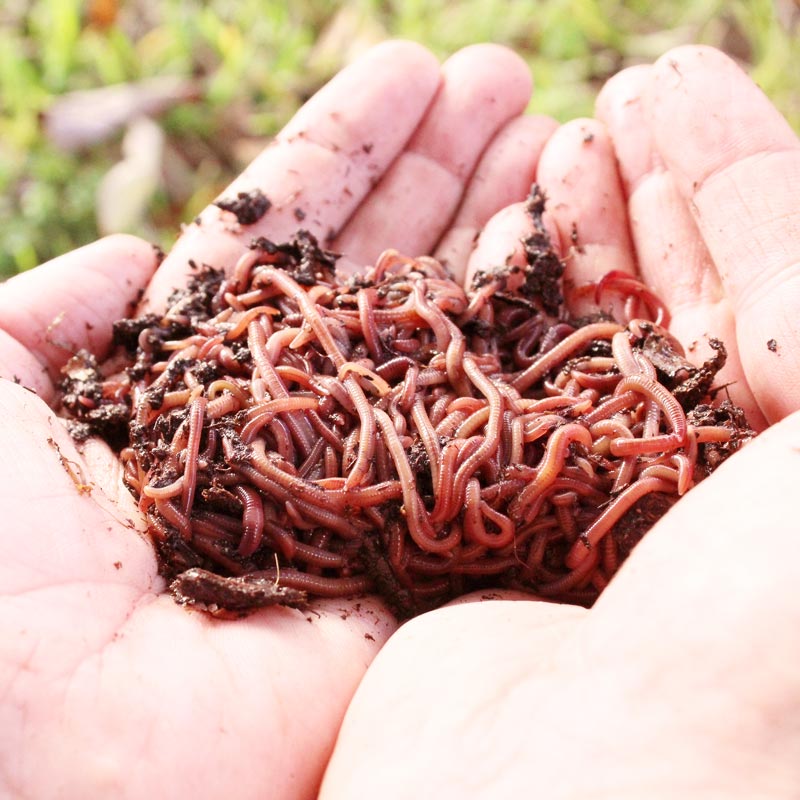Red Wiggler Worms for Sale - Sustainable Waste Monitoring Service
Wiki Article
Red Wiggler Worms Demystified: Unlocking the Keys of Vermiculture for Greener Living and Nutrient-Rich Dirt
In the world of lasting methods for improving soil quality and advertising eco-conscious living, red wiggler worms play a critical yet typically neglected function. These modest animals possess the amazing ability to change organic waste into nutrient-rich castings that act as a potent natural fertilizer. By delving right into the globe of vermiculture, one can uncover a wide variety of advantages that extend much past traditional composting approaches. Recognizing the intricacies of taking care of these worms, optimizing their environment, and using their spreadings can lead to a greener lifestyle and healthier soil for plants to grow.The Function of Red Wiggler Worms
Red Wiggler worms play an important role in composting systems by successfully damaging down natural issue into nutrient-rich spreadings. These starved eaters eat a selection of natural products, such as kitchen area scraps, backyard waste, and paper products. As they feed, the worms' digestive system procedures break down the raw material into a fine, dark, and nutrient-dense product called worm spreadings or vermicompost.The castings created by Red Wiggler worms are very advantageous for soil health and plant development. They are rich in necessary nutrients like potassium, nitrogen, and phosphorus, which are important for sustaining healthy plant advancement. Additionally, worm spreadings contain beneficial germs and enzymes that assist improve soil framework, increase water retention, and improve nutrient uptake by plants.
Advantages of Vermicomposting

It improves dirt framework, enhances dirt oygenation, and enhances dirt wetness retention. Vermicompost also enriches the soil with necessary nutrients like potassium, phosphorus, and nitrogen, advertising plant growth and general soil fertility.
In addition, vermicomposting supports lasting horticulture practices by offering a chemical-free and natural alternative to synthetic plant foods. Red Wiggler Worms. This eco-friendly method not just enriches the soil but also helps in reducing reliance on hazardous chemicals, advertising a greener and more sustainable way of horticulture
Establishing a Worm Bin
When establishing a worm bin for vermicomposting, proper configuration is critical to ensure the success of the composting procedure. The very first action in setting up a worm container is selecting a suitable container. This can be a plastic container or wood box that provides sufficient space for the worms to move around and has appropriate drain holes to avoid waterlogging. Next, a bed linen material such as shredded newspaper, cardboard, or coconut coir ought to be included in the bin. This bedding provides a comfy setting for the worms and helps preserve wetness levels.After adding the bedding, introduce the red wiggler worms to the container. It is recommended to begin with a handful of worms and slowly increase as they multiply. The worms need to after that be given with food scraps such as vegetables and fruit peels, coffee premises, and eggshells. It imp source is vital to prevent including meat, milk, oily, or salted foods to stop bring in bugs and developing undesirable smells.
On a regular basis check the dampness degrees and temperature level in the worm container to guarantee optimal problems for the worms. With proper arrangement and upkeep, the worm container will effectively transform natural waste into nutrient-rich compost for your plants and yard.
Harvesting Worm Spreadings
To effectively collect nutrient-rich worm spreadings from your vermicomposting system, a methodical harvesting technique is essential. There are a few key steps to follow to guarantee a successful process when it comes time to collect the worm spreadings. To start with, stop adding fresh food scraps away of the worm bin for a number of weeks before gathering. This motivates the worms to migrate sideways with fresh bedding and food, making it simpler to dig the spreadings from the opposite side.
Troubleshooting Common Issues
Recognizing and addressing usual difficulties that may emerge during the vermicomposting process is essential for preserving a productive and healthy and balanced worm bin. One usual issue that vermicomposters encounter is overfeeding. Including excess food scraps can cause a build-up of dampness and level of acidity in the worm bin, possibly damaging the worms. To stop this, feed the worms in moderation, making certain that the food scraps are effectively damaged down prior to adding more. One more concern is unpleasant odors emanating from the worm bin. Foul smells indicate anaerobic problems, typically brought on by overwatering or poor air flow. To treat this, readjust the moisture levels by adding completely dry bed linens products like shredded paper or cardboard and boost oygenation by transforming the bedding routinely.
Additionally, if the worm populace is decreasing or the worms show up undesirable, maybe due to ecological stressors such as severe temperature levels or pH levels. Checking these elements and making required adjustments is essential for the wellness of the worms. By repairing these typical issues immediately, vermicomposters can guarantee a smooth and effective vermicomposting process while maintaining a thriving worm populace.

Final Thought
In verdict, red wiggler worms play a vital role in vermiculture by damaging down natural matter helpful site into nutrient-rich soil. Setting up a worm bin is crucial for successful vermiculture, and collecting worm castings provides valuable compost for horticulture.As they feed, the worms' gastrointestinal processes break down the organic issue into a penalty, dark, and nutrient-dense material understood as worm castings or vermicompost.
The spreadings produced by Red Wiggler worms are very beneficial for soil health and wellness and plant growth. Including excess food scraps can lead to a buildup of wetness and level of acidity in the worm bin, possibly hurting the worms.In addition, if the worm population is decreasing or the worms show up undesirable, it might be due to environmental stress factors such as extreme temperatures or pH levels. Establishing up a worm bin is essential for successful vermiculture, and harvesting worm castings supplies useful compost for gardening.
Report this wiki page